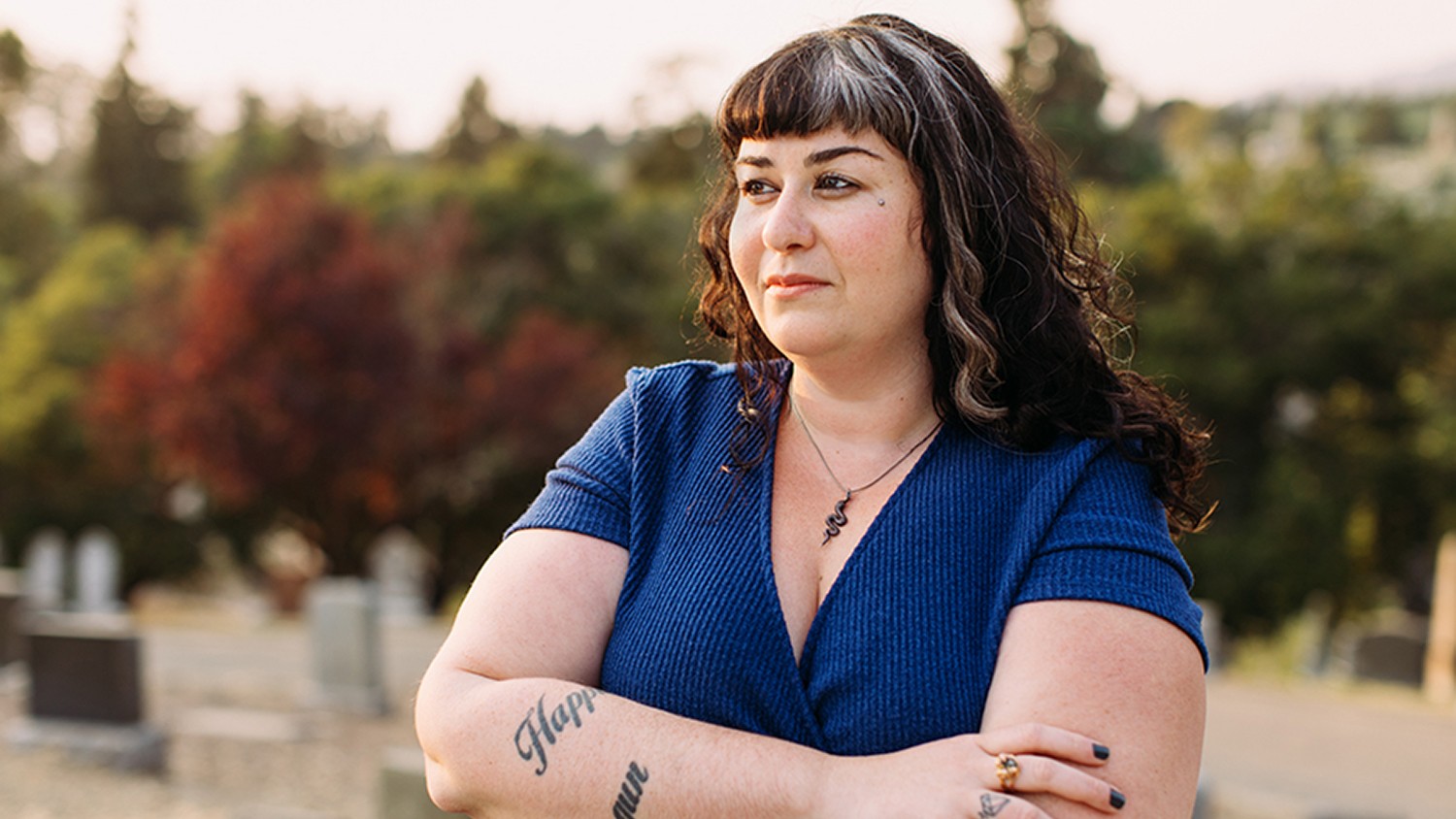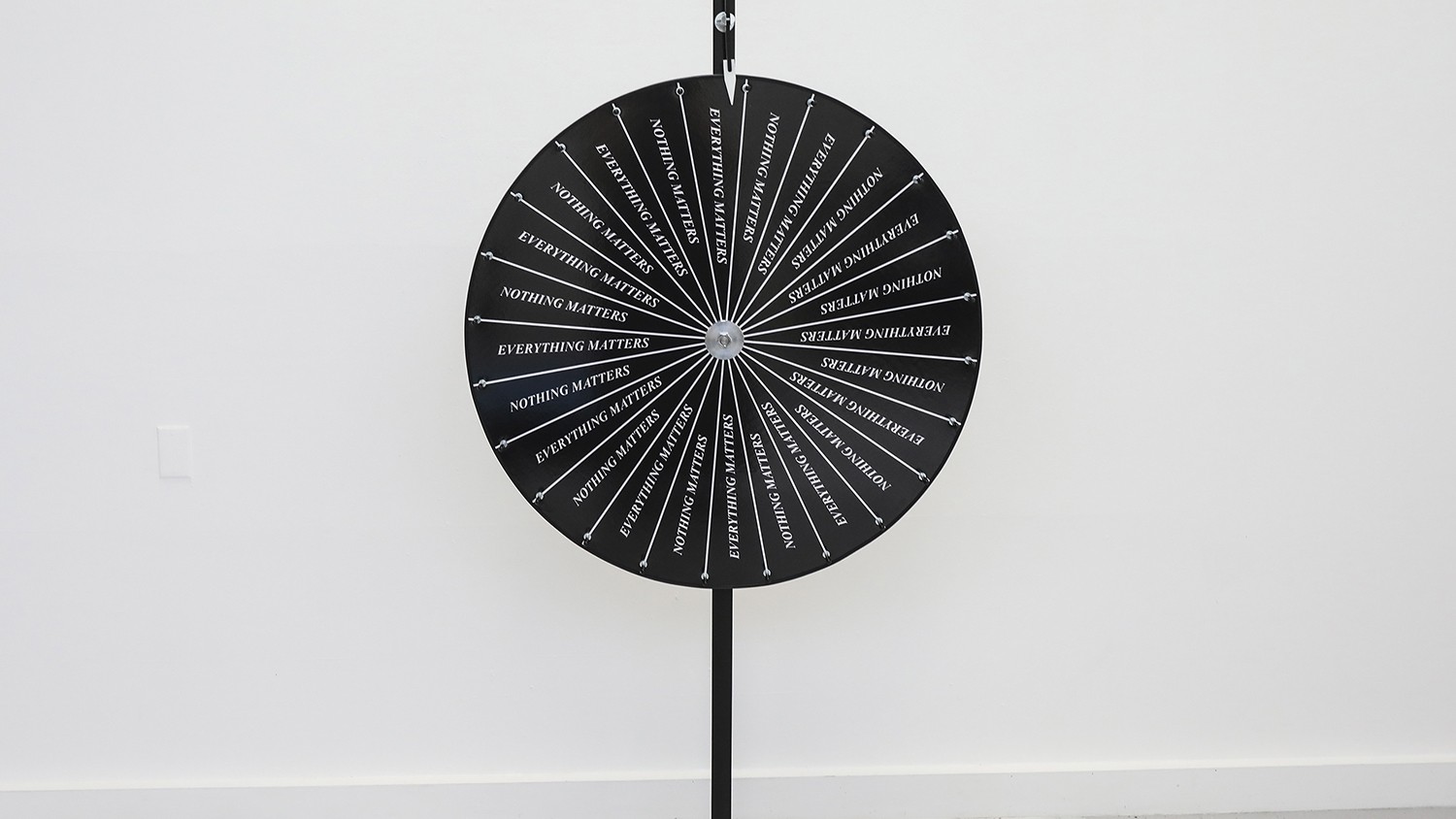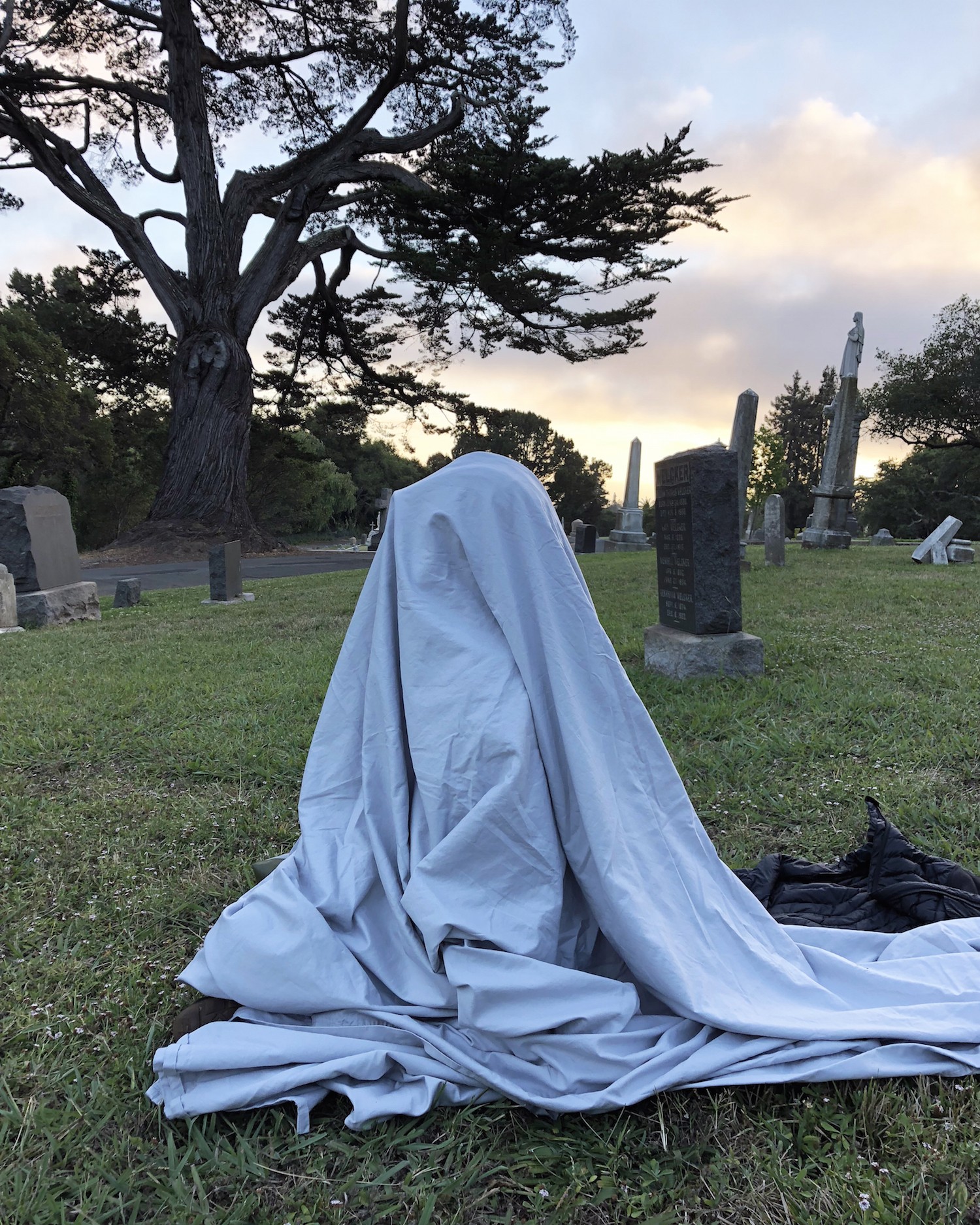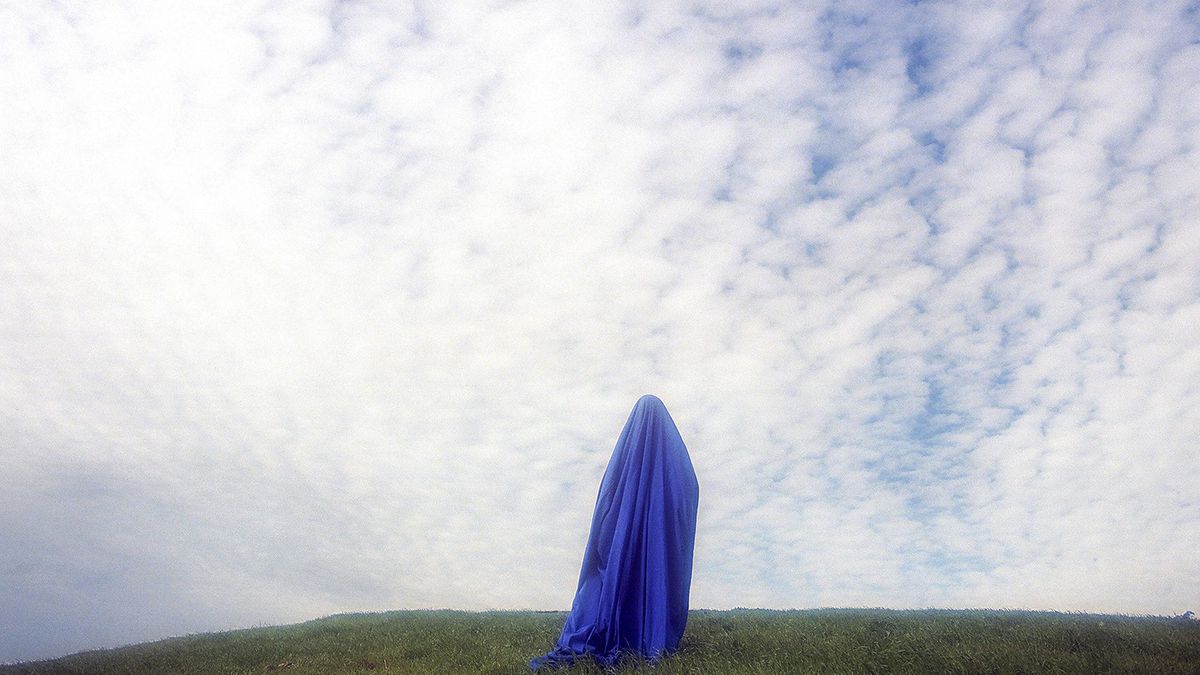
Lindsay Tunkl grabbed my hands as we sat on a blanket surrounded by death. “In this session, it’s really important to know you are in complete control,” she said. “If at any time you feel uncomfortable, you can stop.”
It was a Friday afternoon in the middle of summer, on a grassy knoll under a big oak tree in Oakland’s sweeping, lushly green Mountain View Cemetery. I had agreed to participate in one of Tunkl’s one-on-one performance art sessions, an exercise in coming to terms with our own mortality. What ensued was an hour of death: death discussed, death visualized, and death meditated upon.
She began with a series of questions: What was my first memory of death? Did anyone explain to me what happens when you die? What will happen when I die? Do I identify as someone who is scared to die? Have I thought about how I will die?
Her questions quickly revealed how little I had considered the details of my own end. To her, it’s a common blind spot of human existence. Why aren’t we talking about death more often? “People are dying all the time,” she told me a few weeks later. “It’s one of the greatest events we’ll ever face.”
Tunkl is a 31-year-old artist in Oakland preoccupied with life’s biggest questions, and she investigates them in formats intended to both comfort and challenge you. There are the one-on-one sessions, which can feel as intimate and vulnerable as therapy. There are books, like When You Die You Will Not Be Scared to Die, a recently published collection of musings on all the positive things that might come from death. (“When you die you will stop feeling bad about watching TV.”) And there are familiar objects reimagined with whimsy, such as a large prize wheel people spin to land on one of two conclusions: “everything matters” or “nothing matters.”
That dichotomy is of endless fascination to Tunkl. And it rings especially true today, when people chase personal fulfillment and social media approval in the name of living your best life. At the same time, drastic climate change and political strife signals a society teetering on collapse. Sometimes it feels like a nuclear war could break out at any moment.
As we move into an uncertain, potentially dystopian future, Tunkl seems calm, present, and certainly more ready than me. It’s taken a whirlwind childhood and years of facing both her past and her fears to get to this point in her life — and in her art. Observing Tunkl observe me on our fatality-themed picnic, I wonder if we all confront the end of ourselves, the entire human species, and the world, we will feel truly free.
Experiencing Tunkl’s work is a start.
In 2012, Tunkl was convinced we were all going to die. Her uncle had been talking about planet Nibiru — according to conspiracy theorists at the time, it was going to collide with Earth in five days. Tunkl started to sob uncontrollably. She was visiting her family and nearly canceled her flight home in a state of panic — this could be the last time they would all be together.
“I went into this full-blown other place,” she said. “The planet was coming for us very soon.”
A sinking feeling of terror settled in as Tunkl demanded to know the location of the nearest bunker. She didn’t feel ready for everything to disappear and couldn’t understand why the rest of her family didn’t seem to care. The dismay lasted for hours, and the effects of it, for years.
In the end, the planet didn’t crash through the ozone layer — it doesn’t even exist. But it led to Tunkl’s artistic fascination with the end of the world.
When she began talking to people about Nibiru, she noticed an immediate fervor and a visible twitchiness. Until this point, Tunkl had primarily been making video art grounded in her personal experiences and emotions — art that people commonly told her was too personal and too emotional. Nibiru was the answer to the future of her art practice. A rendering of the planet nearly hitting Earth still hangs above her desk.
“This is where I can talk about my own intense anxiety or fear that’s actually linked to so much more,” she explained. “It’s about loneliness. It’s about loss. It’s about grief. It’s about morals and values. And I can have it be not directly about me. It’s big enough to hold a lot, and narrow enough to hit some puncture points for people.”
Even though Tunkl’s work about death and the apocalypse isn’t exactly about her, it’s very much informed by her past. She’s actually had a lifelong fear of asteroids and Nibiru-like situations. She often dreams about things colliding with Earth, possibly a lasting effect of seeing movies like Armageddon and Deep Impact — two doomsday films about asteroids — at a young age. She’d lay awake at night picturing the end of human existence and anxiously wonder which of her separated parents she’d turn to in her final moments.
Born in Switzerland, Tunkl spent her early years caught between two parents wrestling with drug addictions and a custody battle, she said. She fondly remembers spending a few years on a farm with her mom and some cats in Northern England. There was a forest right next to their house with some swings and abandoned witches’ cauldrons — like real witches, she said — and she went to Catholic school and quickly objected to her teachers’ notes on the Book of Genesis. “What about the Big Bang?” she’d ask.

She was 2 years old when she first encountered the concept of death — it’s one of her very first memories. Her dad was telling her a meandering bedtime story about how humans evolved from monkeys, black holes, how the sun was one day going to burn out, and everything and everyone would die.
Tunkl doesn’t have many happy memories from her childhood. “There was a lot of my mom taking me and disappearing from my dad, and then my dad getting visitation and keeping me for months beyond, and then him disappearing from my mom,” she said. “There was all this weird back and forth as they muddled through their own insanities and addictions and tried to care about having a kid.”
Her mom would often wake her up in the middle of the night and announce they were about to fly to another country. She’d spend long periods of time alone when she probably shouldn’t have been alone. She remembers being 5 years old, playing with a ring on her tongue, choking, and realizing there was no one around to help. She threw her body against the stairs, coughed out the ring, and learned to soothe herself.
Eventually, her mom’s drug addiction got so bad that Tunkl was sent to live with her dad. But he struggled with drugs as well, she said. And then, when Tunkl was 13, she dealt with her own addiction. It started with cannabis, then the over-the-counter cough suppressant Coricidin, also known as Triple C. (“You’re supposed to take one every 24 hours. I was taking 32 in a weekend.”) Then meth. She got arrested the first time she attempted to deal drugs and went to rehab. With the exception of a stint of intense drinking at age 18, she said she’s been sober ever since.
Considering those early years, it’s no wonder Tunkl became so preoccupied with death. “There have been periods of time with my family where I thought, ‘You could die,'” she said, referring to her parents. “I’d wake up every morning thinking, “Is my dad going to be dead today?’ … For a long time it was a big part of my identity, being someone who survived the kind of childhood that I had.”
Tunkl chooses not to dwell on her past anymore, but she doesn’t hide it either.
“The individual experiences she’s had from birth to coming into an adult are insane, almost incomprehensible — how can all of that happen to one person?” said Amanda Ribas-Tugwell, one of Tunkl’s closest friends from graduate school. “With that said, she’s experienced a lot of highs and lows as a kid, and I think that’s created a desire for heightened experience as an adult, in terms of staying stimulated and awake and present. … It’s a gift that comes from some hard places.”
But Tunkl’s survival isn’t the only thing fueling her art. It’s also the intense emotional and healing work that went into mending her relationships with her parents. It’s also the love.
As Ribas-Tugwell put it, “It’s very clear that her art and her life are completely interwoven.”
What does the apocalypse smell like? That’s Tunkl’s first question in Pre Apocalypse Counseling, another round of one-on-one performance art sessions she started holding in 2014. It was preceded by years of research. Tunkl joined message boards and interviewed people, known as preppers, who actively prepare for doomsday scenarios. She even embarked on a two-week solo camping expedition in the name of testing her survival skills. (“What I learned very quickly doing this work was I would not survive,” she said with a laugh. “I should stop trying.”)
The result was a one-hour exploration of the end of the world — Tunkl determined there are 185 different possible forms of the apocalypse — and what you’d do during, say, a nuclear blast, catastrophic tsunami, or Tunkl’s historical favorite, an asteroid collision.
Early on in the sessions, she would ask, “Do you think you would survive an extinction-level event?” Most people said, ‘yes,’ which surprised Tunkl. The other thing that shocked her was hearing how badly people wanted to survive. “Does it make sense to live in desolation with nobody? With nothing? Why? What is it you’re clinging to? … I don’t think people come to those answers out of fear or ignorance,” she said. “It’s because we’re not talking about it enough.”
All sorts of people signed up for these sessions, from folks who adore apocalypse movies to those who claim to never think about it. But after the 2016 presidential election, a rush of people contacted Tunkl for Pre Apocalypse Counseling. Those sessions felt different, more urgent. “This is the end of the world for some people in a very real way,” she said.
The apocalypse work spawned a body of related objects. She collaborated with a scent artist and created a line of perfumes that smelled like different forms of the apocalypse. (Tsunami, for example, gave off a potent whiff of sea mist, green leaves, tidal pull, blue metal, oily smoke, rubber, and oil.) She published Pre Apocalypse Co-Counseling, a handbook for folks to conduct their own sessions at home. San Francisco’s Parallax Press also released Origins and Endings: Seeing Yourself through the Apocalypse, a divination book allowing playful psychoanalysis through an accompanying apocalypse-themed inkblot card deck.

For Julian Carter, critical studies chair at California College of the Arts and one of Tunkl’s former professors, Tunkl’s work manages to be both elegant and conceptually sophisticated, without feeling overly didactic in its message. And her work matches her spirit. “On the one hand, ‘This is my project, and this is what I want to do.’ On the other hand, ‘Here, have some fun, play with it, tell me what it’s like for you.’ It’s so kind and generous,” he said. “Her material is super, super serious but also with a kind of lightness to not be overwhelmed by it. There’s no pretentiousness to this work.”
When it comes to Tunkl’s performance work, Carter said he admires how she creates simple and safe yet appealing spaces for “material that most people understand as messy and uncontrollable,” he said. Carter joined Tunkl for a session of Parting Practice: Rituals for Endings and Failure — the series she held in Mountain View Cemetery — and found that his prior musings on death weren’t as thorough as he had previously thought. Her questions tapped into a larger wisdom he had been contemplating for years, but with a sense of newness. “I feel like she got me every so slightly high,” he said, laughing.
Ribas-Tugwell, a former art gallery manager and art editor of Exberliner Magazine, sees Tunkl’s biggest artistic strength as asking life’s hardest questions while making viewers feel immediately comfortable through familiar, everyday objects and aesthetics.
“I’m so excited to see what her work is like in the next 20 years and so on, because I’m certain she’s on a path that will inevitably result in some extremely profound work, which is not to say her work isn’t profound now,” she said. “She’s only at the beginning of her career but has already tapped into this space in contemporary art, which is to make art accessible but also challenging. It’s the goal of most contemporary art, but most of the time it doesn’t happen.”
It’s worth noting that Tunkl doesn’t charge people for her one-on-one sessions — evidence of her anti-capitalist beliefs as well as her complicated relationship with money. She grew up poor with her mom, accustomed to sharing one bed with her and her sister as well as constantly moving between hotels and condemned housing. But her father was a wealthy art dealer — a level of commodification of art that Tunkl doesn’t believe in — and his large Hollywood hills house eventually became her home. It’s a big reason why much of her art is not for sale. (But she does have to pay rent, so some of it is.) It’s also why she focuses on human connection.
That said, she’s working on a new body of work that doesn’t include a one-on-one aspect. (“You know how some painters, they just do the same painting? I don’t want to do that with the one-on-ones. I don’t want to just do the same painting.”) Instead, the eventual exhibit, A Knife Under the Bed Splits the Pain in Two, will build on a question she’s been asking for a long time: How do we decide if something is meaningful or meaningless? One piece, for example, will be two large, side-by-side prints of the entireties of two plays: Romeo and Juliet and Waiting for Godot.
“In Romeo and Juliet, everything matters, love is so important, everyone dies,” she explained. “In Waiting for Godot, nothing matters, they talk about killing themselves, they stay alive indefinitely.”
She’ll continue to wrestle with the deep unknowns of life, but in a more everyday way instead of on a deadly or cosmic level. “Politically, how do I wake up every morning, knowing what’s going on with the world, and just have a daily life? How do I make sense of it? It doesn’t make sense. It’s unrecognizable,” she said. “How do I not play into feeling like the world is a trap?”
About halfway through our Parting Practice session in Mountain View Cemetery, I laid down, closed my eyes, and listened to birds singing, planes flying overhead, and Tunkl’s soft voice guiding me through meditation.
“As you take four breaths, become connected, aware of the ground that you’re laying on, gravestones around you, the caskets under you, the bodies that have been here for 150 years,” she said.
“The first truth about death is that death is certain. Once death comes, you cannot change it. It is also true that your life is constantly running out. You cannot replace any of it. … The causes of death are infinite. You could die because of a storm or an accident. You could die of cancer or heart disease or old age. You could die of fear. You could even die of a broken heart. And on the other hand, you could be diagnosed with a terminal illness and it may not be the cause of your death. What this tells us is that your body is extremely fragile and vulnerable. Your life hangs by but a breath. Take a deep breath in and a deep breath out.”
Then, Tunkl placed a baby blue sheet over my entire body. In this art practice, I became a ghost. What did it feel like to be a ghost? What would I do if I were a ghost? Would I haunt my loved ones? Would I wait for them in loneliness?

We gazed at the sky and sucked on lemons, listening to 1965’s “Baby I’m Yours” by Barbara Lewis. I’ll be yours until the stars fall from the sky / Yours until the rivers all run dry / In other words, until I die. In the past hour, I had thought about deadly bike accidents, my ideal afterlife, religion, consumerism, Burning Man, and Black Mirror. I reflected on the Chinese Buddhist chants that played as my grandfather neared his end, the way my mother covered my eyes when his body descended into the ground, the rituals we maintain to keep memories alive, and whether any of it truly matters. Even without an answer, I felt at total peace. I felt transported. I felt a way art so rarely makes me feel, and so fully.
At the end, I asked her what she hoped people take away from the experience.
“Whatever they need to,” she said. “I try to not have attachment to the outcome. It becomes too complicated to have attachment to what you want people to experience.”
Indeed, that’s what makes it art and not therapy. And unlike a therapist, Tunkl doesn’t just ask questions. She is an active part of the experience, someone who also feels and wonders and maybe even cries. What makes Tunkl’s practice so effective is her own open vulnerability. She brings similar thoughtfulness and sensitivity to conversations about white guilt, queer identity, art’s role in gentrification, and the problems with capitalism. No matter the format, her work always returns to one central question: What matters?
“I believe that so much of the fucked up shit that is happening in the world is because of fear, not talking to each other, not being able to relate to each other, and not having empathy for each other,” Tunkl said.
“I kind of feel like love is the answer but don’t want to say it,” she continued, laughing. “How can you say love is going to solve the Trump problem? You can’t. But I also believe it can somehow. Love is an action. What does love as an action look like? Active listening. Giving someone an hour of your time for free and asking the hard questions. Really being present for another human being.”












